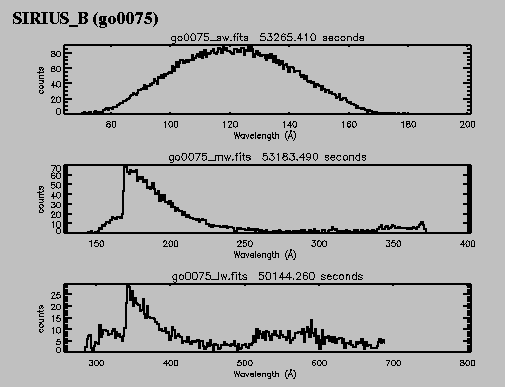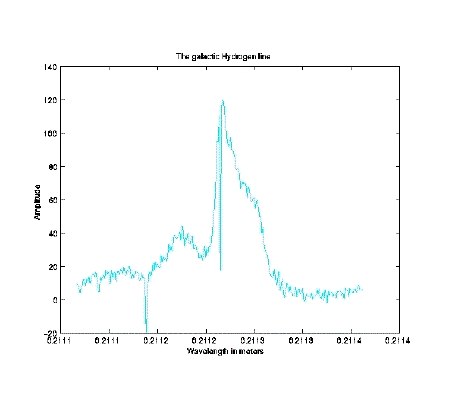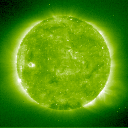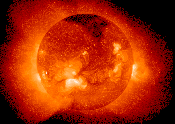
| Light Basics | Types of Light | Light Gallery | The EM Spectrum |
 Objective: Try to Determine the Type of Light Shown in Spectra of Objects in Space
Objective: Try to Determine the Type of Light Shown in Spectra of Objects in Space
you will use the tool in the bottom frame to answer the questions
What Kinds of Light are Being Produced by Objects in Space? This is the most important, if not quite the only question that astronomers ask. So now you've tried your hand at judging the wavelength sizes of different kinds of light.
The graphs below are called spectra. What do they show? Remember when we talked about the intensity of light waves? Well these graphs show the intensity of light at many different wavelengths, as measured by instruments called spectrometers (spectro + meter, or measure). The bottom, or horizontal axis of each graph is a scale of wavelengths, and at each point, the line of the graph gives the intensity of that wavelength in units of counts. Counts just means the number of times the spectrometer detected light of that particular wavelength during the observation. Light at any one wavelength, could be detected very few times, or a great many times, and that's what makes the shape of the spectrum graph.
If you received a spectrum like the next three graphs below, of the white dwarf star Sirius B would you be able to tell us what kind of light it's producing? Give it a try!

![]() The Spectrum of the White Dwarf Star Sirius B:
The spectrum has been broken into three parts to make it fit the page. Look at the horizontal axis;
this is the line at the bottom of the three
rectangular sections of the spectrum. Do you notice a familiar unit
of measurement? What is the numerical wavelength range covered by
this spectrum? That is, what are the shortest and longest wavelengths shown? Use the Tool in the Frame Below to figure out what kind of light this is.
The Spectrum of the White Dwarf Star Sirius B:
The spectrum has been broken into three parts to make it fit the page. Look at the horizontal axis;
this is the line at the bottom of the three
rectangular sections of the spectrum. Do you notice a familiar unit
of measurement? What is the numerical wavelength range covered by
this spectrum? That is, what are the shortest and longest wavelengths shown? Use the Tool in the Frame Below to figure out what kind of light this is.
Here's a more difficult problem: Try determining the light type of the next spectrum. You will need to convert the units of the horizontal axis from meters to angstroms,
The Galactic Hydrogen Line Spectrum! What type of light is shown in this spectrum? The spectrum is famous and known as the "21 centimeter hydrogen line" spectrum. The central peak of the graph shows a distinctive type of light that is produced by hydrogen molecules. It was made by observing diffuse hydrogen gas in the space within our Galaxy.

Unlike the last spectrum, this one
has its horizontal
axis (where you find the wavelength values) labeled
in meters.
In order to use the wavelength analyzer tool you
must to convert these
measurements into angstroms. You might
find it useful
to know that there are .00000001 cm in an angstrom. Here is a simple,
graphic way to think about the unit conversion:
| Å × cm = cm |
| Å |
You can think of the angstrom units as "canceling out," the way a common factor does when you multiply fractions. You already have the number of centimeters "per" angstrom, so you should be able to do the conversion easily. If you don't remember the conversion factor, go back to the definition of Angstrom.
Use the Tool in the
Frame Below, which works for angstroms, to figure out what kind of light this is.
Can you guess what object(s) in space these images show?
![]() But, Do Objects In Space Produce Only One Type of Light?
But, Do Objects In Space Produce Only One Type of Light?
When you look at the Sun, you are seeing it in visible light. But does it produce other kinds of light as well? Yes, for example, a star like our Sun may be detected in visible light, infrared, X-ray, extreme ultraviolet and ultraviolet light.
An object in our Universe can produce many kinds of light (visible, infrared, gamma ray, etc.) So, it is often useful to look at an object
along the entire electromagnetic spectrum. However, because different light types are recorded by different equipment, scientists often must use several means to record all the different kinds of light produced by one object.


 How Do Scientists Record Light Types that are Not Visible to the Human Eye?
How Do Scientists Record Light Types that are Not Visible to the Human Eye?
Visible light can be seen through an optical telescope, however,
many types of light are "captured" or "detected" in different ways. Can you think of some possible ways of recording
non-visible light?
Although your eyes can not see ultraviolet light from a star, one way to
capture and record
it is to let the star's light pass through a 1) filter and then fall on a 2) detector. Astronomers use filters to "filter out" the types of light from an object that they are not currently studying. For instance, a metal, glass, or plastic foil filter works to only let a certain range of light through. Once astronomers have only the light they are studying,
they can
let the light fall on a photographic plate (which, unlike the human eye, can detect types of light like ultraviolet
light), or a solid state device
called a CCD.
A CCD is like a tiny tray with many
electronic "pockets." Each
pocket detects the light that falls on it,
and a computer program is used to add them
all up, like tiles in a mosaic.
This produces a "picture" of the star in ultraviolet light.
Another example of detecting
non
 Go
to the next page to find out more about
different instruments that detect different
kinds of light.
Go
to the next page to find out more about
different instruments that detect different
kinds of light.
Light Basics
Types of Light
Light Gallery
The EM Spectrum
Copyright © 1996-2001 Regents of the University of California